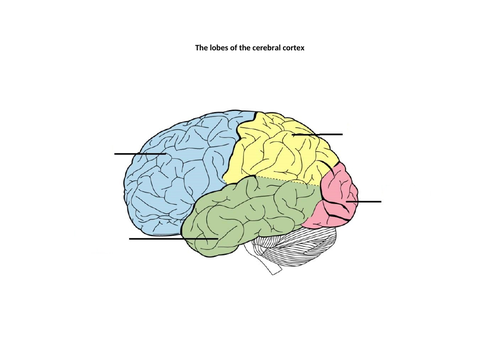



This lesson describes the structure and localised function of the frontal, occipital, temporal and parietal lobes of the cerebrum. The PowerPoint and accompanying resources are part of the 2nd lesson in a series of 17 lessons that cover the details of the brain and neuropsychology topic of the AQA GCSE Psychology specification.
In the previous lesson, the students were introduced to the cerebrum as two hemispheres connected by the corpus callosum. This lesson builds on this by introducing the cerebral cortex as the outer layer which is divided into four lobes in each hemisphere. A series of quizzes are used throughout the lesson to introduce key terms in an engaging and (hopefully) memorable way, and through one quiz, the students will discover the names of the 4 lobes and recognise where they are located. Moving forward, students will learn about the function of each lobe, including the localised function of the motor, somatosensory, visual, auditory, Broca’s and Wernicke’s areas.
This topic of the brain and neuropsychology has proved particularly difficult for the students in recent years, so I have taken time to analyse the lesson sequencing. There’s a lot of content to absorb and to understand before moving onto the next part, so I’ve tried to ensure that cross topics links and prior knowledge checks run throughout the lessons. I have organised the lessons to run through the biology content first before moving onto the psychology parts as shown by the 17 lessons below:
#1 Organisation of the nervous system
#2 The structure and function of the cerebral lobes
#3 The cerebellum
#4 The structure and function of the sensory and motor neurones
#5 The relay neurones
#6 Synaptic transmission
#7 Excitation and inhibition at the synapse
#8 The somatic nervous system
#9 The autonomic nervous system
#10 The fight or flight response
#11 James-Lange theory of emotion
#12 James-Lange theory of emotion part 2
#13 Penfield’s study of the interpretative index
#14 Hebb’s theory of learning and neuronal growth
#15 An introduction to neuropsychology
#16 Brain scanning techniques
#17 Tulving’s gold memory study
Something went wrong, please try again later.
This resource hasn't been reviewed yet
To ensure quality for our reviews, only customers who have purchased this resource can review it
Report this resourceto let us know if it violates our terms and conditions.
Our customer service team will review your report and will be in touch.